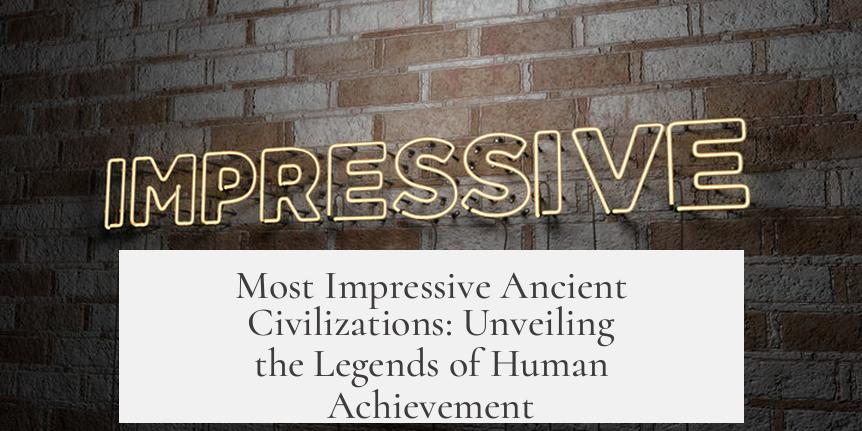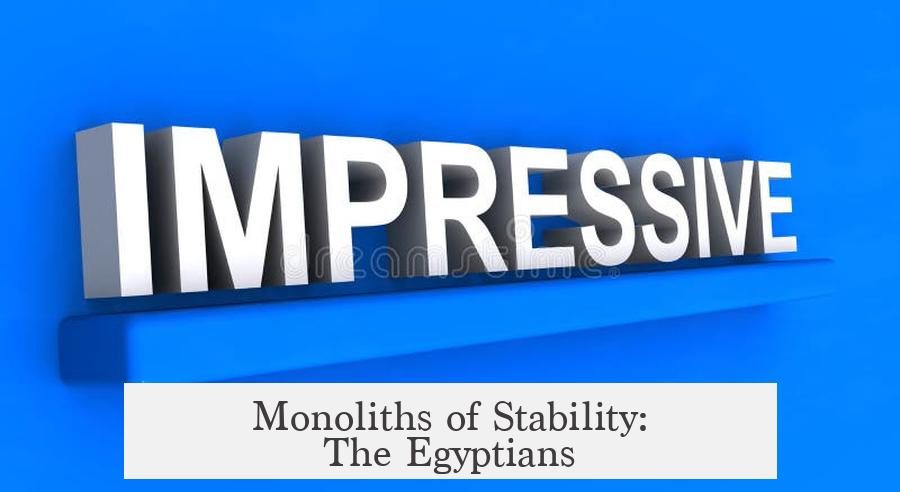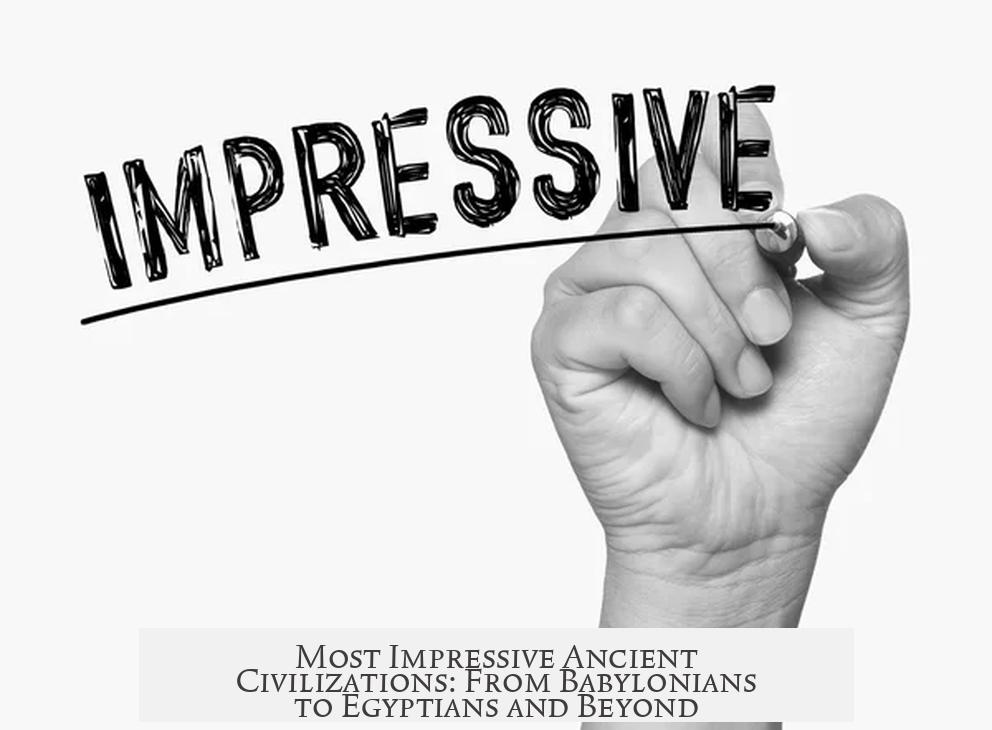The most impressive ancient civilizations each stand out for unique contributions to human history, culture, technology, and governance. Key civilizations such as the Babylonians, Romans, Sumerians, Greeks, Shang Dynasty China, Egyptians, Indus Valley, Achaemenid Persia, and others shaped the foundations of the modern world through innovations in law, science, infrastructure, social organization, and culture.
The Babylonians introduced fundamental time concepts and legal systems used today. They established the 7-day week and the 60-based measurement of time (60 seconds per minute, 60 minutes per hour). Their Code of Hammurabi is one of the earliest legal codes, influencing justice systems. Babylonian astronomers handed down the 12 zodiac constellations, an early step in celestial mapping.
The Romans are renowned for their military power, legal framework, and governance. The Twelve Tables remain foundational in European law. Rome also acted as a conduit, spreading Hellenistic knowledge widely across Europe and parts of Asia. Their influence is visible in administrative systems and concepts of justice adopted in modern institutions.
The Sumerians contributed literary and architectural achievements. They produced the Epic of Gilgamesh, the first known literary work created for entertainment rather than religious or practical reasons. Their ziggurat cities showed early urban planning. Historical records point to Ur in Sumer as the birthplace of monotheism, tied to Abraham in biblical texts.
The Greeks (Hellenes) excelled in intellectual and cultural innovation. They pioneered philosophy, science, history, geometry, democracy, and drama. Herodotus, the father of history, named the discipline. Greek contributions underpin many modern academic and political systems. They combined intellectual prowess with strong military and political leadership.
Shang Dynasty China laid early bureaucratic and infrastructural foundations. Though following eras experienced fragmentation, this dynasty set precedents that later dynasties like the Song built upon. The Han Dynasty also stands out for a strong military and trade networks, reinforcing China’s position as a major ancient empire.
Ancient Egypt maintained continuity for over 3,000 years. Their society evolved yet preserved a stable lifestyle. This longevity is remarkable alongside significant innovations, including pyramids, complex religious systems, and advances in medicine and engineering.
The Indus River Valley civilization ranks among the largest and most advanced early urban centers. They developed sophisticated flood irrigation, written language, and strict urban planning with grid-based cities. The society was notably pacifist and engaged extensively in long-distance trade.
Achaemenid Persia excelled in managing a vast empire through efficient bureaucracy. This empire controlled territories from the Nile Delta to the Indus Valley and parts of Greece. Their system supported cohesion across diverse cultures and geographies, a notable administrative accomplishment.
The Khmer Empire is recognized primarily for its architectural feats, exemplified by the Angkor Wat temple complex. Similarly, the Islamic Empire showed brilliance through distinctive architecture, a rich tradition in writing, and advances in mathematics and science.
Other notable societies include the Majapahit Empire, known for active trade across Southeast Asia; the Mali Empire, famous for gold wealth and vibrant trade networks; and the Han Dynasty, cited for combining military strength with commerce.
| Civilization | Key Contributions |
|---|---|
| Babylonian | Time system, legal codes, zodiac constellations |
| Roman | Law, military, governance, Hellenistic cultural spread |
| Sumerian | First literature (Epic of Gilgamesh), urban planning, monotheism link |
| Greek (Hellenic) | Philosophy, science, history, democracy, arts |
| Shang Dynasty | Bureaucracy, infrastructure foundations |
| Egyptian | Longevity, innovation, stable civilization |
| Indus Valley | City planning, irrigation, written language, peaceful society |
| Achaemenid Persia | Empire management, bureaucracy |
| Khmer Empire | Architecture (Angkor Wat) |
| Islamic Empire | Architecture, writing, mathematics |
| Majapahit Empire | Trade |
| Mali Empire | Gold wealth, trade |
| Han Dynasty | Trade, military strength |
- Babylonian innovations in time and law influenced modern systems.
- Roman legal and military structures shaped Western civilization.
- Sumerians pioneered entertainment literature and urban design.
- Greek philosophy and democracy founded key intellectual traditions.
- Shang and Han dynasties contributed administrative and military advancements.
- Egypt’s long-lasting civilization combined stability with innovation.
- Indus Valley urban planning set standards in city design and pacifism.
- Achaemenid Persia perfected large-scale empire management.
- Khmer and Islamic empires excelled in architecture and culture.
- Trade flourished in Majapahit, Mali, and Han empires, enriching regions.
Most Impressive Ancient Civilizations: Unveiling the Legends of Human Achievement

When pondering the most impressive ancient civilizations, one might imagine towering pyramids or sprawling empires. But what truly makes an ancient civilization impressive? Is it their innovations, their longevity, or the legacies they left behind? Let’s dive into a fascinating exploration of history’s most remarkable societies and their unique contributions to our world.
First off, it’s worth noting when ancient civilizations transition into what historians call Late Antiquity or Medieval History. In the UK, this shift occurs around AD 467, after the fall of the Western Roman Empire. So, our focus stays firmly on that remarkable ancient era.
The Pioneers of Time and Law: The Babylonians
Meet the Babylonians: the unofficial architects of our modern calendar system. Yes, they gave us the very concept of a 7-day week, and believe it or not, the first known weekend. Their ideas about time division within a day mirror our own; their base-6 mathematics gifted us the 60 seconds in a minute and 60 minutes in an hour. Walk into any party and tell someone this – instant win!
Babylon’s Code of Hammurabi is another gem—one of the earliest known laws, setting standards for justice thousands of years ago. Plus, their astronomers gifted us the twelve zodiac constellations (even if their names have evolved). Essentially, if you trace back your weekly horoscope, you tip your hat to them.
Epic Literature and Urban Wonders: The Sumerians
Now, let’s talk about the Sumerians, who didn’t just invent writing but penned the first known literary masterpiece meant purely for entertainment: the Epic of Gilgamesh. Think of it as the world’s first blockbuster story, centuries before Hollywood. This tale inspired countless narratives, books, and even video games—proof that storytelling is a timeless human obsession.
Additionally, the Sumerians built impressive ziggurat cities—massive step pyramids that housed temples. Their city of Ur holds a special place in religious history, believed to be the birthplace of monotheism and Abraham’s original home. That’s some spiritual heritage right there.
The Greek Touch: Brilliance in Thought and Culture

It’s hard to discuss ancient civilizations without tipping the hat to the Greeks. They are arguably the “total package”: inventing science, philosophy, drama, geometry, democracy, and even history itself, thanks to Herodotus, the ‘father of history.’
Their influence spreads beyond intellectual realms into politics and warfare. The Hellenes combined warrior spirit and thought leadership seamlessly. Without Greek philosophy, our education and government systems would be unrecognizable. What modern democracy thinks itself better than a debate in an Athenian assembly?
The Romans: Masters of Law and Empire
The Romans, often admired for their vast empire and military might, deserve credit especially for advancing our concepts of law and justice. Their Twelve Tables laid a foundation still influencing European law today.
However, some historians suggest Rome’s main claim to fame is as a conduit—spreading Greek culture far and wide. Imagine schools without Latin classes but Greek history instead. Still, Rome’s infrastructure and legal framework made a lasting impact.
China’s Early Architects: Shang and Han Dynasties
Ancient China’s Shang dynasty laid crucial groundwork for bureaucracy and infrastructure. Their organized systems later evolved during the Song dynasty, though eras of turmoil sometimes hampered progress.
The Han Dynasty, another heavyweight, impressed with their robust army and extensive trade networks. They truly demonstrated how military strength and commerce can shape an empire’s success.
Monoliths of Stability: The Egyptians

What about the Egyptians? Their civilization impresses with longevity—over 3,000 years of largely continuous culture. They balanced innovation with tradition, incrementally refining their lifestyle while taking monumental steps in architecture, medicine, and religion. Their enduring identity amid change is a marvel.
Other Giants: Persia, Indus Valley, and Beyond
- Achaemenid Persia: Mastered bureaucracy better than anyone, keeping a vast empire stable from Egypt to the Indus Valley. They had more than armies; they had management down to an art.
- Indus River Valley Civilization: The urban planners of the ancient world. Their cities followed strict grids, flood irrigation, and an emphasis on peaceful trade make them stand out amongst contemporaries.
- Khmer Empire: Renowned for stunning architecture, especially Angkor Wat, which continues to captivate visitors centuries later.
- Islamic Empire: Made strides in mathematics, architecture, and writing systems that influenced Europe and the wider world.
- Majapahit Empire: An impressive trading powerhouse in Southeast Asia.
- Mali Empire: Known for its immense wealth in gold and trade networks across Africa.
So, which ancient civilization takes the crown for being the MOST impressive? It depends on what you value—innovation, longevity, cultural impact, or empire management. Each society brought unique gifts to humanity.
What lessons can modern societies learn from these ancient marvels? Perhaps the Babylonian sense of time management, the Sumerians’ love for storytelling, the Greeks’ pursuit of knowledge, or Persia’s bureaucratic finesse. These civilizations remind us that progress often blends innovation with tradition.
“History isn’t just about the past; it’s the toolkit for the future.”
When you next glance at a clock, flip a law book open, or enjoy a story, remember—the seeds were planted thousands of years ago, by some truly impressive pioneers.
What key contributions did the Babylonians make to modern timekeeping?
The Babylonians created the 7-day week and introduced the weekend. They used a base-6 math system, which gave us 60 seconds in a minute and 60 minutes in an hour.
Why are the Sumerians important in the history of literature?
They wrote the Epic of Gilgamesh, the first known story created purely for entertainment, influencing storytelling across millennia.
How did the Achaemenid Persian Empire excel in managing its vast territory?
They pioneered effective bureaucracy, enabling the empire to govern territories from the Nile to the Indus smoothly, surpassing prior administrative systems.
What made the Indus River Valley Civilization stand out among ancient cultures?
It was the largest early river valley civilization known for flood irrigation, advanced city planning on grid systems, written language, long-distance trade, and a pacifist society.
In what ways did the Greeks influence modern knowledge and culture?
The Greeks developed the foundations of science, philosophy, democracy, literature, and history. Their ideas shaped many disciplines still studied today.




